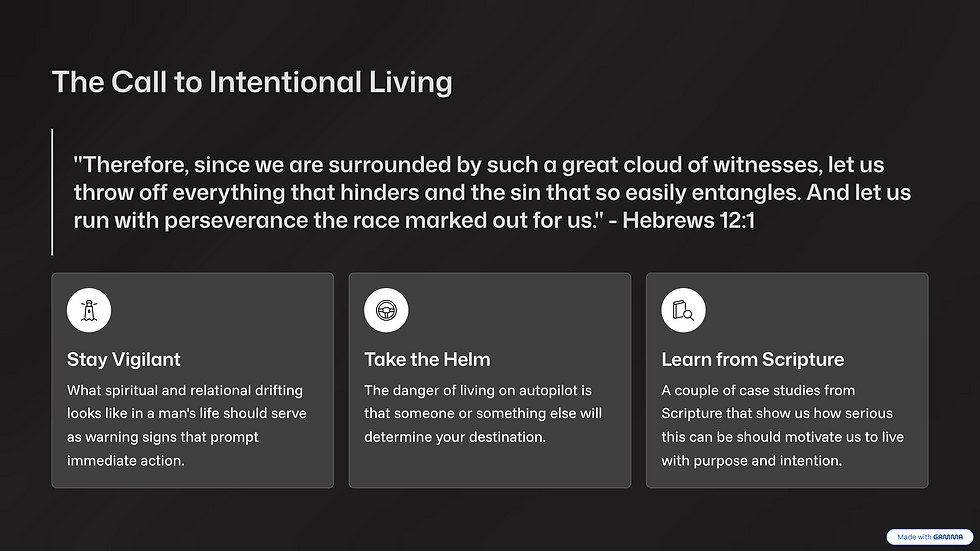Overcoming Drift: A Journey Toward Purpose
- Douglas Kuhl
- Aug 20
- 4 min read
Updated: 15 hours ago
Welcome, brother. I’m glad you’re here. If you’re reading this, it probably means you’ve felt something profound inside that you can’t quite ignore anymore. Maybe you’ve sensed that life has gotten off course—that somewhere along the way, you’ve started drifting.

Drifting is subtle. It’s rarely one big decision, but a hundred small ones. It’s the gradual slide from intention to autopilot. If we don’t recognize it early, drift will always carry us further than we ever wanted to go.

What Spiritual Drift Looks Like
Let me ask you a tricky question: Have you ever been more passionate about Jesus than you are right now? If the answer is yes, that’s a sign you may be drifting.
Drift in a man’s spiritual life often looks like this:
Prayer feels mechanical, rushed, or almost nonexistent.
Bible reading is more of an obligation than a hunger.
Church attendance may be consistent, but engagement is half-hearted.
There’s no fire, no expectancy, no sense of God’s nearness.
It’s not that you’ve rejected God—you still believe—but the intimacy, the closeness, has faded. Recognizing this drift is the first step toward renewal.
What Relational Drift Looks Like
Drift doesn’t just show up spiritually. It sneaks into our relationships, too:
With your wife: Conversations shrink down to logistics—kids, bills, schedules. The emotional connection that once drew you together is replaced by polite co-existence.
With your kids: You’re there physically, but absent emotionally. You know their activities but not their hearts.
With your friends: Conversations stay on the surface—sports, work, maybe some church talk—but no one really knows what’s happening deep inside you.
And here’s the truth: drift feels easier in the short term. It asks nothing of you. But left unchecked, it robs you of everything that matters.

The Danger of Living on Autopilot
Picture a boat that loses its anchor. At first, it looks like it’s in the same place. But little by little, the current carries it downstream. That’s what happens when a man lives on autopilot.
Autopilot feels safe:
You go to work, pay the bills, keep the routines.
Nobody complains—you look “successful.”
But underneath, your soul is slowly dying.
The greatest danger of drift is that it doesn’t feel dangerous—until it’s too late.
Case Studies from Scripture
Two men in the Bible illustrate the dangers of drifting: Samson and Saul.
Samson – The Drifter by Compromise
Gifted with supernatural strength and a calling from God.
But drifted through compromise.
Small choices—flirting with temptation, ignoring God’s commands—pulled him further and further away.
By the end, the man called to deliver Israel was enslaved, blind, and mocked by his enemies.
Drift doesn’t start with rebellion. It starts with small compromises that add up.
Saul – The Drifter by Fear
Called to be Israel’s king.
Drifted because of fear and insecurity.
He sought the approval of people instead of trusting God.
His drift cost him his kingdom, his peace, and his legacy.
Both men started strong. Both were called by God. But drift destroyed them. Brother, don’t miss this: nobody drifts into greatness. You only drift into regret.
Real-World Connection
Maybe you see yourself in Samson—drifting by compromise. Giving in to temptation, letting “small” sins erode your integrity. Or maybe you see yourself in Saul—drifting by fear. Worrying more about appearances than obedience, more about success than faithfulness.
Either way, drift leads to emptiness. If we want to build a legacy that lasts, we have to stop living on autopilot and take the wheel back—with God’s help.
Finding Purpose in the Drift
Understanding Your Drift
To truly overcome drift, we must first understand it. Reflect on your life. Where are you feeling disconnected? What areas feel stagnant? Acknowledging these feelings is a vital step toward healing.
Reconnecting with God
Reconnecting with God is essential. Spend time praying and meditating. Ask Him to reveal areas of your life where you may be drifting. As you seek Him, you will find clarity and direction. Remember, God is always ready to welcome you back.

Engaging with Relationships
Next, focus on your relationships. Reach out to your wife, kids, and friends. Have open conversations about your feelings. Vulnerability can strengthen bonds and bring you closer together. It’s okay to admit that you’re struggling.
Taking Action
Finally, take action. Set small, achievable goals to reconnect spiritually and relationally. This could mean scheduling regular family nights, joining a Bible study, or simply dedicating time each day to prayer. Every step counts.

Key Takeaways
Drift occurs gradually but can lead to profound consequences.
Spiritual drift manifests as a loss of intimacy with God, while relational drift is characterized by emotional distance from others.
Samson and Saul remind us that drift always costs more than we think.
Reflection Challenge
Take 10–15 minutes today and journal your honest reflections:
Where have I been living my spiritual life on autopilot?
What signs of drift do I see in my marriage, family, or friendships?
Which Bible character do I identify with more right now—Samson or Saul—and why?
(If you’re brave, share one of these reflections with a trusted friend or accountability partner.)
Remember, you are not alone on this journey. We all face moments of drift, but with God’s guidance, we can find our way back to purpose and fulfillment.




Comments